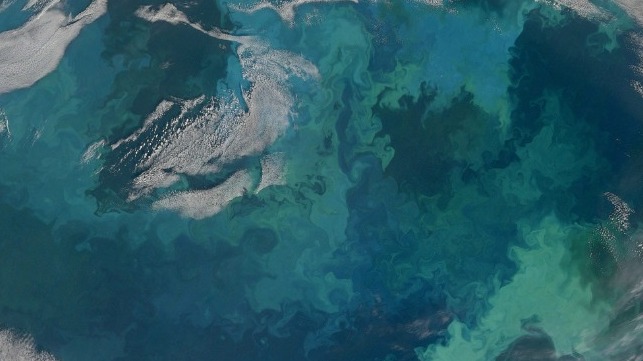The headline quote is from oceanographer John Martin during a 1988 lecture at Woods Hole Oceanographic Institution. Here's NASA's Earth Observatory archive page on the statement.
It is a bit of an exaggeration, you may need ten of those Valemax bulk carriers, currently the second largest ships in the world at 400,000 dwt (Euronav's two TI oil tankers at 441,000 dwt are bigger), to make an environmental change but what a change it would be. The orders of magnitude of carbon the iron-fed plankton would sequester are almost mind-boggling:
...Martin gathered the results of the incubation experiments and laid out the evidence in support of the Iron Hypothesis together with some back‐of‐the‐envelope calculations and presented his findings at a Journal Club lecture at Woods Hole Oceanographic Institution in July of 1988. He estimated that using a conservative Fe : C ratio that 300,000 tons of iron in the Southern Ocean induce the growth of phytoplankton that could draw down an estimated two billion tons of carbon dioxide. Then, putting on his best Dr. Strangelove accent, he suggested that “with half a ship load of iron….I could give you an ice age.” The symposium broke up with laughter and everyone retired to the lawn outside the Redfield Building for beers (from Chisholm and Morel, Editors, preface to: What controls phytoplankton production in nutrient‐rich areas of the open sea? Limnology and Oceanography, 36, 8 December 1991).
As repeated in "John Holland Martin: From Picograms to Petagrams and Copepods to Climate"
—Bulletin of Limnology and Oceanography, Wiley. 25 March 2016

In late March, as most of the world was adjusting to lockdown, oceanographer Daniel Harrison was setting sail for the Great Barrier Reef. Though Harrison, a native Australian, had sailed these waters many times before, this particular expedition was different.
On reaching Broadhurst Reef, 100km off the Australian coast, Harrison and his skeleton crew of local scientists – just a few with permission to travel – noticed white corals stretching out in every direction, a sign that the reef was bleaching, and dying, from heat stress. This would be the third mass bleaching of the Great Barrier Reef in just five years, an event that is becoming more likely as the global ocean warms.
Harrison and his team were there to test a radical intervention that, if successful, could spare the world’s largest coral reef from total loss. Known as marine cloud brightening, their approach involves spraying seawater into the air to help form bright clouds that reflect sunlight and cool the waters below. “This is like putting the reef on life support while we deal with the underlying cause. It buys us some time” says Harrison. “Obviously bringing emissions down is the critical thing.”
Climate intervention
While Harrison’s project is small in scale, and in its infancy, marine cloud brightening is just one of numerous practices – collectively known as geoengineering or climate intervention – that could cool the planet, offsetting some of the harm caused by greenhouse gas pollution. With global emissions rising, there’s a growing awareness that we’ll likely need such radical measures to avoid dangerous climate change. “Emissions reductions alone are not going to cut it,” says Phillip Boyd, a marine biogeochemist at the University of Tasmania, Hobart. “We’ve got an increasingly fast-moving problem, and so we may need increasingly fast-moving countermeasures,” says Kelly Wanser, founder of US non-profit Silver Lining, which advocates for research into climate intervention....
....MUCH MORE
Coming up tomorrow, the Pope, and a Vancouver stock promoter.
Our series thus far:October 27
Plankton Week: "Metal deposits from Chinese coal plants end up in the Pacific Ocean, research shows"
October 26
"Plankton Bloom Heralded Earth’s Greatest Extinction"